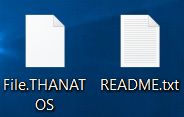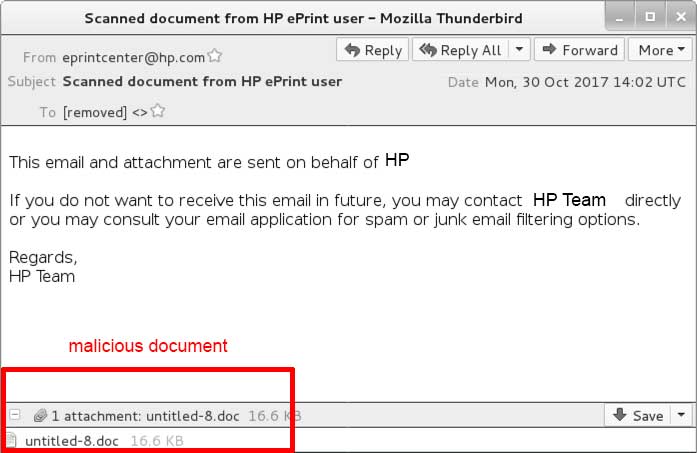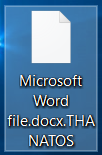 This article has been created in order to help explain what is Thanatos ransomware virus and how to restore files encrypted by it, containing the .THANATOS file suffix added to them.
This article has been created in order to help explain what is Thanatos ransomware virus and how to restore files encrypted by it, containing the .THANATOS file suffix added to them.
The .THANATOS ransomware is the type of infection you do not want on your computer. The malware is from the ransomware kind, meaning that it’s primary purpose is to encrypt the files on your computer and make them no longer able to be opened, at least until a hefty ransom fee has been paid to the cyber-criminals who are behind the infection. The ransomware demands a $200 US ransom in either BitCoin, Ethereum or BitCoin cash and if your computer has been infected by it, we recommend that you read the following article to learn how to remove it and restore files, encrypted by this malware on your computer.

Threat Summary
| Name | .THANATOS Files Virus |
| Type | Ransomware, Cryptovirus |
| Short Description | Aims to encrypt the files on the computers infected by it and asks victims to pay $200 in cryptocurrencies to get them decrypted. |
| Symptoms | Files are no longer able to be opened and now contain the .THANATOS file extension. |
| Distribution Method | Spam Emails, Email Attachments, Executable files |
| Detection Tool |
See If Your System Has Been Affected by malware
Download
Malware Removal Tool
|
User Experience | Join Our Forum to Discuss .THANATOS Files Virus. |
| Data Recovery Tool | Windows Data Recovery by Stellar Phoenix Notice! This product scans your drive sectors to recover lost files and it may not recover 100% of the encrypted files, but only few of them, depending on the situation and whether or not you have reformatted your drive. |

.THANATOS Files Virus – How Did I Get infected
The primary method by which your computer could have gotten infected by this ransomware infection is via opening an e-mail spam message’s attachment. Most cyber-crooks take up to spread massive spam campaigns whose primary purpose is to deceive inexperienced users to open malicious attachments, making it seem like they are documents of great importance, like the fake e-mail in the example below shows:
In addition to via spam e-mails, the .THANATOS ransomware may also spread via other malicious files, that are uploaded directly on suspicious websites or even torrent sites. The most often disguised files are believed to be:
- Fake setups of programs or games.
- Fake game patches, cracks or key generators.
- Fake software license activators.

.THANATOS Files Virus – More Information and Activity
Once an infection with this ransomware virus takes place, it immediately employs a resource fork which contains all of the malicious commands within. This specific infection method is used to obfuscate the malicious files from any protection software or against reverse engineering. Security researchers believe that the .THANATOS files virus also has information extraction modules embedded within it, and these also aim to query your OS’s kernel. In addition to this, the Thanatos ransomware’s engine can also check if specific Windows processes are actively running on your computer and take actions towards ending those tasks. Futhermore, this infection also has the ability to detect any sandbox environments, debuggers as well as check if it’s running on a virtual machine and delete itself if o.
Once Thanatos ransomware has infected a computer, the malware modifies the following Windows Registry sub-key adding entries to run ‘Microsoft Update System Web-Helper’ and README.txt to run automatically:
→ HKEY_CURRENT_USER\Software\Microsoft\Windows\CurrentVersion\Run “Microsoft Update System Web-Helper” = “C:\Windows\System32\notepad.exe %UserProfile%\Desktop\README.txt”
The ransom note of .THANATOS, is named README.txt and it aims to scare the victims off into paying ransom. What is particularly interesting about it is that this variant of Thanatos is the first ransomware to ask a ransom payoff in BitCoin Cash:
—————————————————
________ _____ _ _____ __________ _____
/_ __/ / / / | / | / / |/_ __/ __ \/ ___/
/ / / /_/ / /| | / |/ / /| | / / / / / /\__ \
/ / / __ / ___ |/ /| / ___ |/ / / /_/ /___/ /
/_/ /_/ /_/_/ |_/_/ |_/_/ |_/_/ \____//____/—————————————————
Thanatos v1.1Your files was encrypted. To decrypt your files,
follow next steps:1. Send $200 to one of these wallets:
BTC: 1HvEZ1jZ7BWgBYPxqCvWtKja3a9hsNa9Eh
ETH: 0x92420e4D96E5A2EbC617f1225E92cA82E24B03ef
BCH: qzuexhcqmkzcdazq6jjk69hkhgnme25c35s9tamz6f2. Send your TXID and your MachineID to mail
E-Mail: thanatos1.1@yandex.com
Machine ID: {ID HERE}—————————————————
Do not waste your time, files can only be
decrypted by our decode tool.
In addition to the ransom note, the Thanatos ransomware also has information stealing ability and it uses it to steal a lot of data from the computers infected by this virus and this information can even include:
- Passwords and logins.
- Your IP address and System Language.
- What antivirus software is installed on your computer system.
But the Thanatos ransomware’s primary purpose is to encrypt the files and when it does this, the malware does not leave a private decryption key behind, which means that even if you pay the ransom, there is a real chance that the cyber-crooks won’t be able to decrypt your files.

Thanatos Ransomware – Encryption Process
In order to encrypt the files on your computer system, THANATOS ransomware generates a new encryption key for each of the files that have been encrypted by the virus. As stated above, the virus does not save ay corresponding decryption keys, making it virtually impossible to decrypt the files, since the likely algorithm used requires a separate key for each file’s decryption and those cannot be found, even in an encrypted format. The files which may be encrypted by the .THANATOS files virus are believed to be the following types of files:
- Videos.
- Images.
- Audio files.
- Backups.
- Documents.
- Archives.
The encryption process is conducted in the following way – the virus detects the file, replaces key data from the encrypted file, making it no longer usable. The virus then adds the .THANATOS file extension, making the files appear like the following image shows:

Remove Thanatos Ransomware and Restore .THANATOS Encrypted Files
In order to remove this ransomware infection from your computer, reccomendations are to follow the removal instructions underneath this article. They are divided in manual and automatic removal instructions and if you do not feel confident in removing this ransomware infection manually, we recommend that you do the removal process automatically, preferably by downloading an advanced anti-malware software, as experts often advise doing. Such will automatically clean your computer from all of the malicious objects, related to .THANATOS files virus and make sure that your computer system stays protected in the future as well.
If you want to restore your files in the event that they have been encrypted by this ransomware infection, we advise you to follow the file recovery instructions in step ‘2. Restore files encrypted by .THANATOS Files Virus’ below. They may not be 100% guarantee you will be able to restore all your data, but they are a helpful method, allowing you to recover at least some of the files, if you haven’t formatted your drive.
- Step 1
- Step 2
- Step 3
- Step 4
- Step 5
Step 1: Scan for .THANATOS Files Virus with SpyHunter Anti-Malware Tool



Ransomware Automatic Removal - Video Guide
Step 2: Uninstall .THANATOS Files Virus and related malware from Windows
Here is a method in few easy steps that should be able to uninstall most programs. No matter if you are using Windows 10, 8, 7, Vista or XP, those steps will get the job done. Dragging the program or its folder to the recycle bin can be a very bad decision. If you do that, bits and pieces of the program are left behind, and that can lead to unstable work of your PC, errors with the file type associations and other unpleasant activities. The proper way to get a program off your computer is to Uninstall it. To do that:


 Follow the instructions above and you will successfully delete most unwanted and malicious programs.
Follow the instructions above and you will successfully delete most unwanted and malicious programs.
Step 3: Clean any registries, created by .THANATOS Files Virus on your computer.
The usually targeted registries of Windows machines are the following:
- HKEY_LOCAL_MACHINE\Software\Microsoft\Windows\CurrentVersion\Run
- HKEY_CURRENT_USER\Software\Microsoft\Windows\CurrentVersion\Run
- HKEY_LOCAL_MACHINE\Software\Microsoft\Windows\CurrentVersion\RunOnce
- HKEY_CURRENT_USER\Software\Microsoft\Windows\CurrentVersion\RunOnce
You can access them by opening the Windows registry editor and deleting any values, created by .THANATOS Files Virus there. This can happen by following the steps underneath:


 Tip: To find a virus-created value, you can right-click on it and click "Modify" to see which file it is set to run. If this is the virus file location, remove the value.
Tip: To find a virus-created value, you can right-click on it and click "Modify" to see which file it is set to run. If this is the virus file location, remove the value.
Before starting "Step 4", please boot back into Normal mode, in case you are currently in Safe Mode.
This will enable you to install and use SpyHunter 5 successfully.
Step 4: Boot Your PC In Safe Mode to isolate and remove .THANATOS Files Virus





Step 5: Try to Restore Files Encrypted by .THANATOS Files Virus.
Method 1: Use STOP Decrypter by Emsisoft.
Not all variants of this ransomware can be decrypted for free, but we have added the decryptor used by researchers that is often updated with the variants which become eventually decrypted. You can try and decrypt your files using the instructions below, but if they do not work, then unfortunately your variant of the ransomware virus is not decryptable.
Follow the instructions below to use the Emsisoft decrypter and decrypt your files for free. You can download the Emsisoft decryption tool linked here and then follow the steps provided below:
1 Right-click on the decrypter and click on Run as Administrator as shown below:

2. Agree with the license terms:

3. Click on "Add Folder" and then add the folders where you want files decrypted as shown underneath:

4. Click on "Decrypt" and wait for your files to be decoded.

Note: Credit for the decryptor goes to Emsisoft researchers who have made the breakthrough with this virus.
Method 2: Use data recovery software
Ransomware infections and .THANATOS Files Virus aim to encrypt your files using an encryption algorithm which may be very difficult to decrypt. This is why we have suggested a data recovery method that may help you go around direct decryption and try to restore your files. Bear in mind that this method may not be 100% effective but may also help you a little or a lot in different situations.
Simply click on the link and on the website menus on the top, choose Data Recovery - Data Recovery Wizard for Windows or Mac (depending on your OS), and then download and run the tool.
.THANATOS Files Virus-FAQ
What is .THANATOS Files Virus Ransomware?
.THANATOS Files Virus is a ransomware infection - the malicious software that enters your computer silently and blocks either access to the computer itself or encrypt your files.
Many ransomware viruses use sophisticated encryption algorithms to make your files inaccessible. The goal of ransomware infections is to demand that you pay a ransom payment to get access to your files back.
What Does .THANATOS Files Virus Ransomware Do?
Ransomware in general is a malicious software that is designed to block access to your computer or files until a ransom is paid.
Ransomware viruses can also damage your system, corrupt data and delete files, resulting in the permanent loss of important files.
How Does .THANATOS Files Virus Infect?
Via several ways..THANATOS Files Virus Ransomware infects computers by being sent via phishing emails, containing virus attachment. This attachment is usually masked as an important document, like an invoice, bank document or even a plane ticket and it looks very convincing to users.
Another way you may become a victim of .THANATOS Files Virus is if you download a fake installer, crack or patch from a low reputation website or if you click on a virus link. Many users report getting a ransomware infection by downloading torrents.
How to Open ..THANATOS Files Virus files?
You can't without a decryptor. At this point, the ..THANATOS Files Virus files are encrypted. You can only open them once they are decrypted using a specific decryption key for the particular algorithm.
What to Do If a Decryptor Does Not Work?
Do not panic, and backup the files. If a decryptor did not decrypt your ..THANATOS Files Virus files successfully, then do not despair, because this virus is still new.
Can I Restore "..THANATOS Files Virus" Files?
Yes, sometimes files can be restored. We have suggested several file recovery methods that could work if you want to restore ..THANATOS Files Virus files.
These methods are in no way 100% guaranteed that you will be able to get your files back. But if you have a backup, your chances of success are much greater.
How To Get Rid of .THANATOS Files Virus Virus?
The safest way and the most efficient one for the removal of this ransomware infection is the use a professional anti-malware program.
It will scan for and locate .THANATOS Files Virus ransomware and then remove it without causing any additional harm to your important ..THANATOS Files Virus files.
Can I Report Ransomware to Authorities?
In case your computer got infected with a ransomware infection, you can report it to the local Police departments. It can help authorities worldwide track and determine the perpetrators behind the virus that has infected your computer.
Below, we have prepared a list with government websites, where you can file a report in case you are a victim of a cybercrime:
Cyber-security authorities, responsible for handling ransomware attack reports in different regions all over the world:
Germany - Offizielles Portal der deutschen Polizei
United States - IC3 Internet Crime Complaint Centre
United Kingdom - Action Fraud Police
France - Ministère de l'Intérieur
Italy - Polizia Di Stato
Spain - Policía Nacional
Netherlands - Politie
Poland - Policja
Portugal - Polícia Judiciária
Greece - Cyber Crime Unit (Hellenic Police)
India - Mumbai Police - CyberCrime Investigation Cell
Australia - Australian High Tech Crime Center
Reports may be responded to in different timeframes, depending on your local authorities.
Can You Stop Ransomware from Encrypting Your Files?
Yes, you can prevent ransomware. The best way to do this is to ensure your computer system is updated with the latest security patches, use a reputable anti-malware program and firewall, backup your important files frequently, and avoid clicking on malicious links or downloading unknown files.
Can .THANATOS Files Virus Ransomware Steal Your Data?
Yes, in most cases ransomware will steal your information. It is a form of malware that steals data from a user's computer, encrypts it, and then demands a ransom in order to decrypt it.
In many cases, the malware authors or attackers will threaten to delete the data or publish it online unless the ransom is paid.
Can Ransomware Infect WiFi?
Yes, ransomware can infect WiFi networks, as malicious actors can use it to gain control of the network, steal confidential data, and lock out users. If a ransomware attack is successful, it could lead to a loss of service and/or data, and in some cases, financial losses.
Should I Pay Ransomware?
No, you should not pay ransomware extortionists. Paying them only encourages criminals and does not guarantee that the files or data will be restored. The better approach is to have a secure backup of important data and be vigilant about security in the first place.
What Happens If I Don't Pay Ransom?
If you don't pay the ransom, the hackers may still have access to your computer, data, or files and may continue to threaten to expose or delete them, or even use them to commit cybercrimes. In some cases, they may even continue to demand additional ransom payments.
Can a Ransomware Attack Be Detected?
Yes, ransomware can be detected. Anti-malware software and other advanced security tools can detect ransomware and alert the user when it is present on a machine.
It is important to stay up-to-date on the latest security measures and to keep security software updated to ensure ransomware can be detected and prevented.
Do Ransomware Criminals Get Caught?
Yes, ransomware criminals do get caught. Law enforcement agencies, such as the FBI, Interpol and others have been successful in tracking down and prosecuting ransomware criminals in the US and other countries. As ransomware threats continue to increase, so does the enforcement activity.
About the .THANATOS Files Virus Research
The content we publish on SensorsTechForum.com, this .THANATOS Files Virus how-to removal guide included, is the outcome of extensive research, hard work and our team’s devotion to help you remove the specific malware and restore your encrypted files.
How did we conduct the research on this ransomware?
Our research is based on an independent investigation. We are in contact with independent security researchers, and as such, we receive daily updates on the latest malware and ransomware definitions.
Furthermore, the research behind the .THANATOS Files Virus ransomware threat is backed with VirusTotal and the NoMoreRansom project.
To better understand the ransomware threat, please refer to the following articles which provide knowledgeable details.
As a site that has been dedicated to providing free removal instructions for ransomware and malware since 2014, SensorsTechForum’s recommendation is to only pay attention to trustworthy sources.
How to recognize trustworthy sources:
- Always check "About Us" web page.
- Profile of the content creator.
- Make sure that real people are behind the site and not fake names and profiles.
- Verify Facebook, LinkedIn and Twitter personal profiles.




